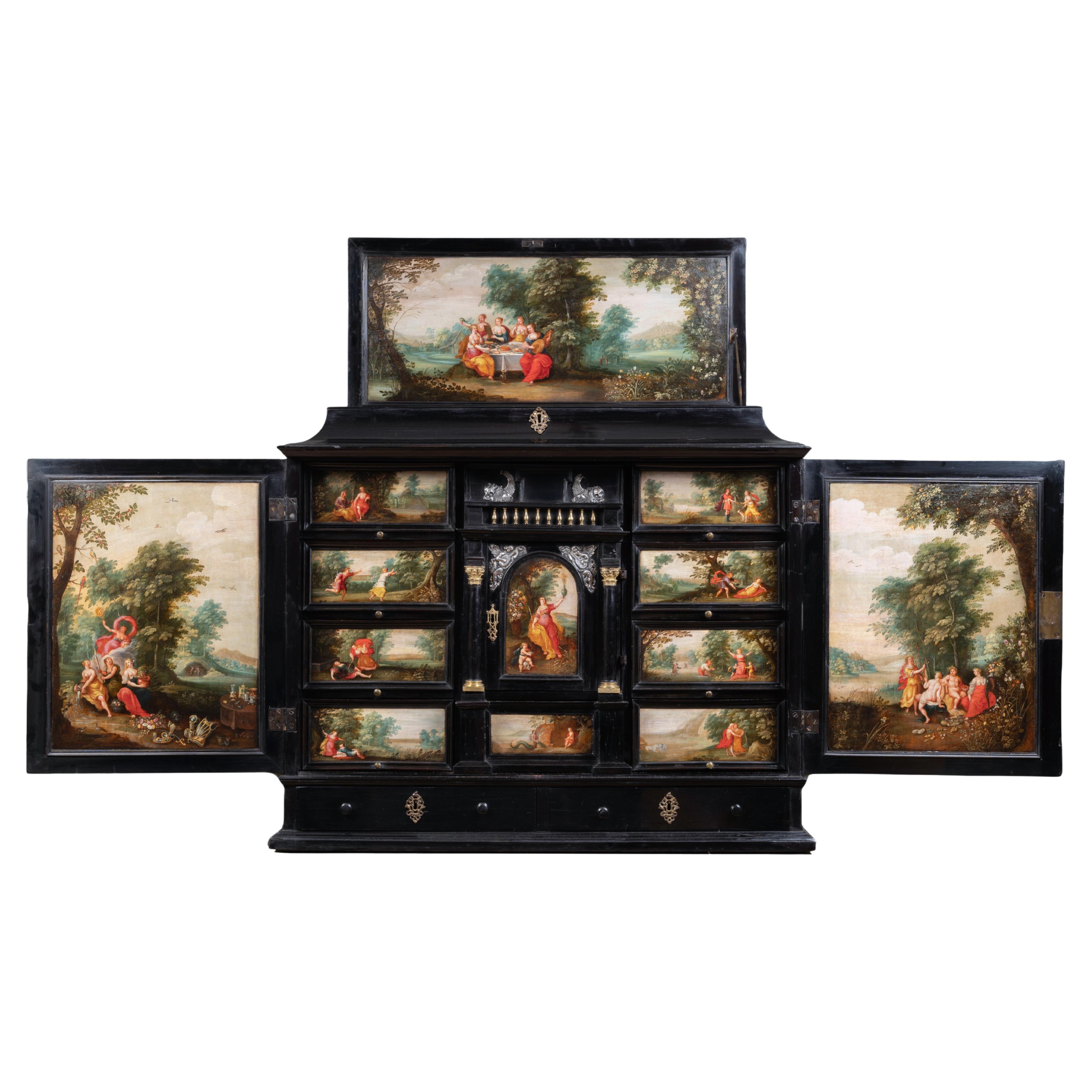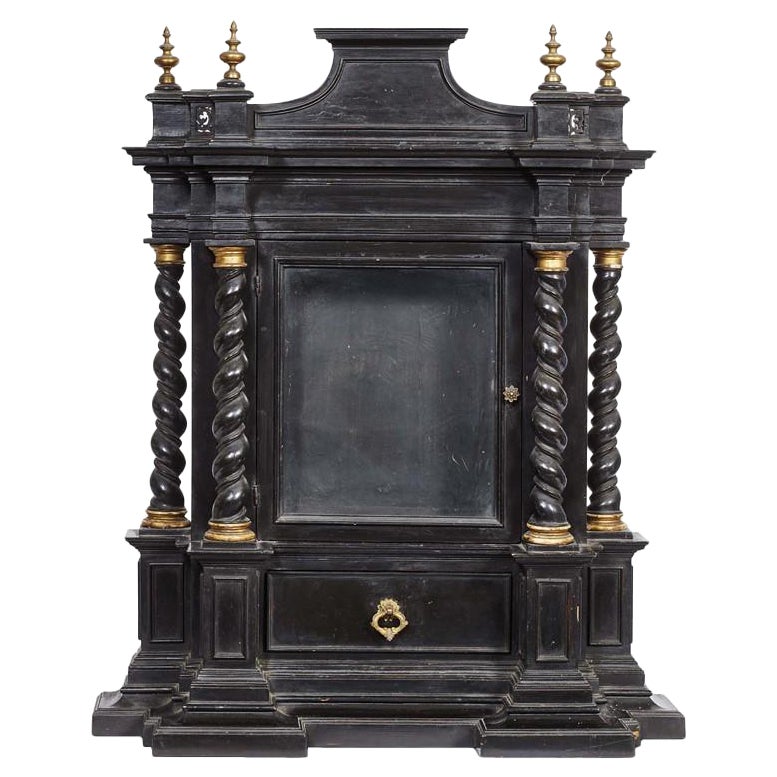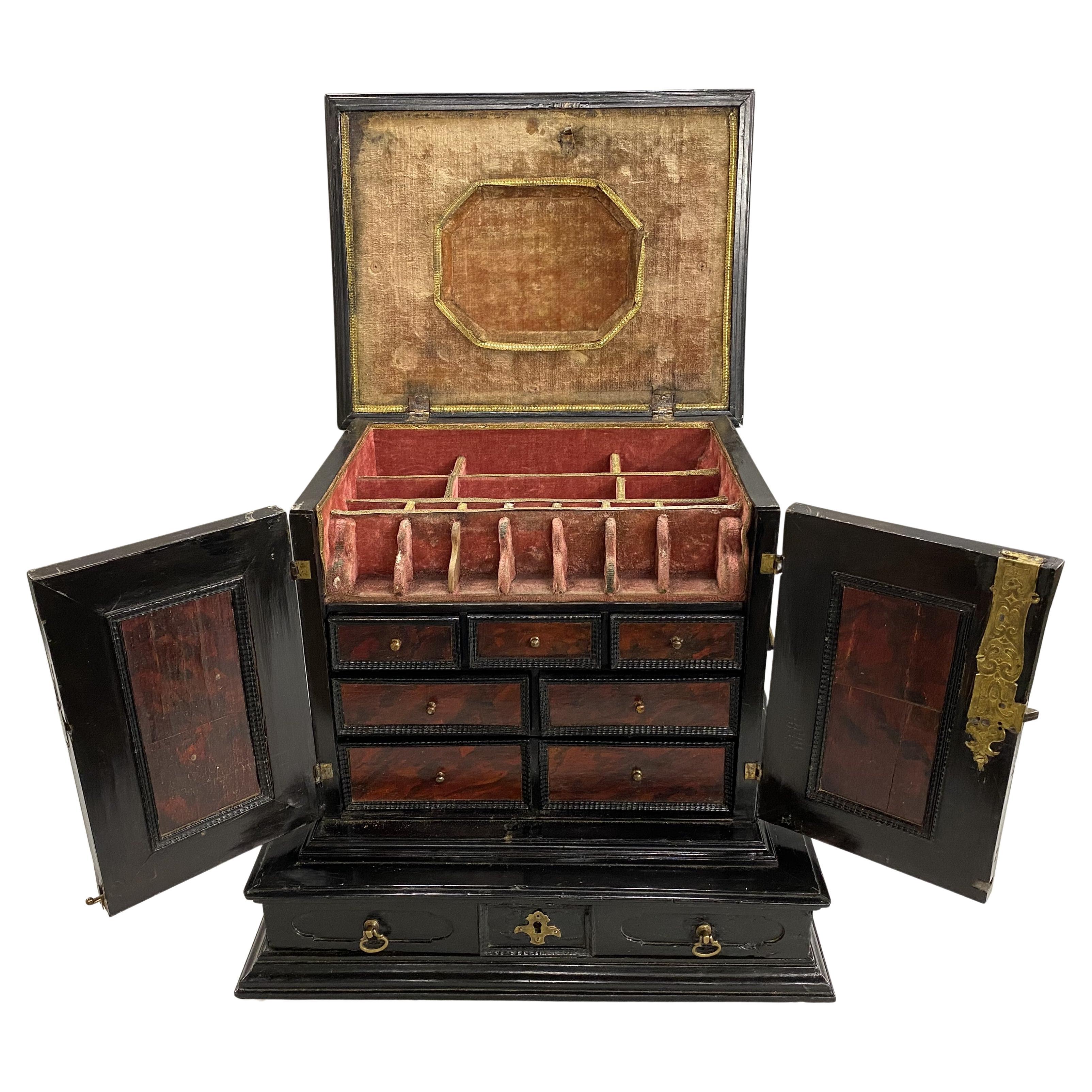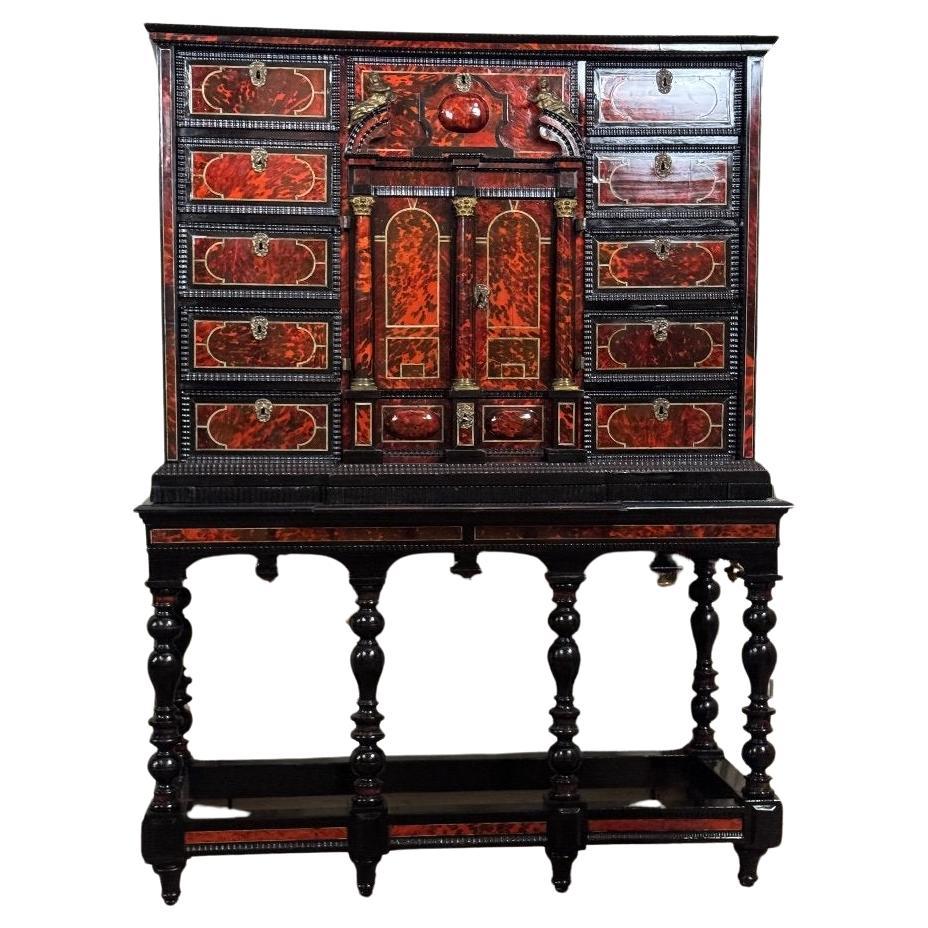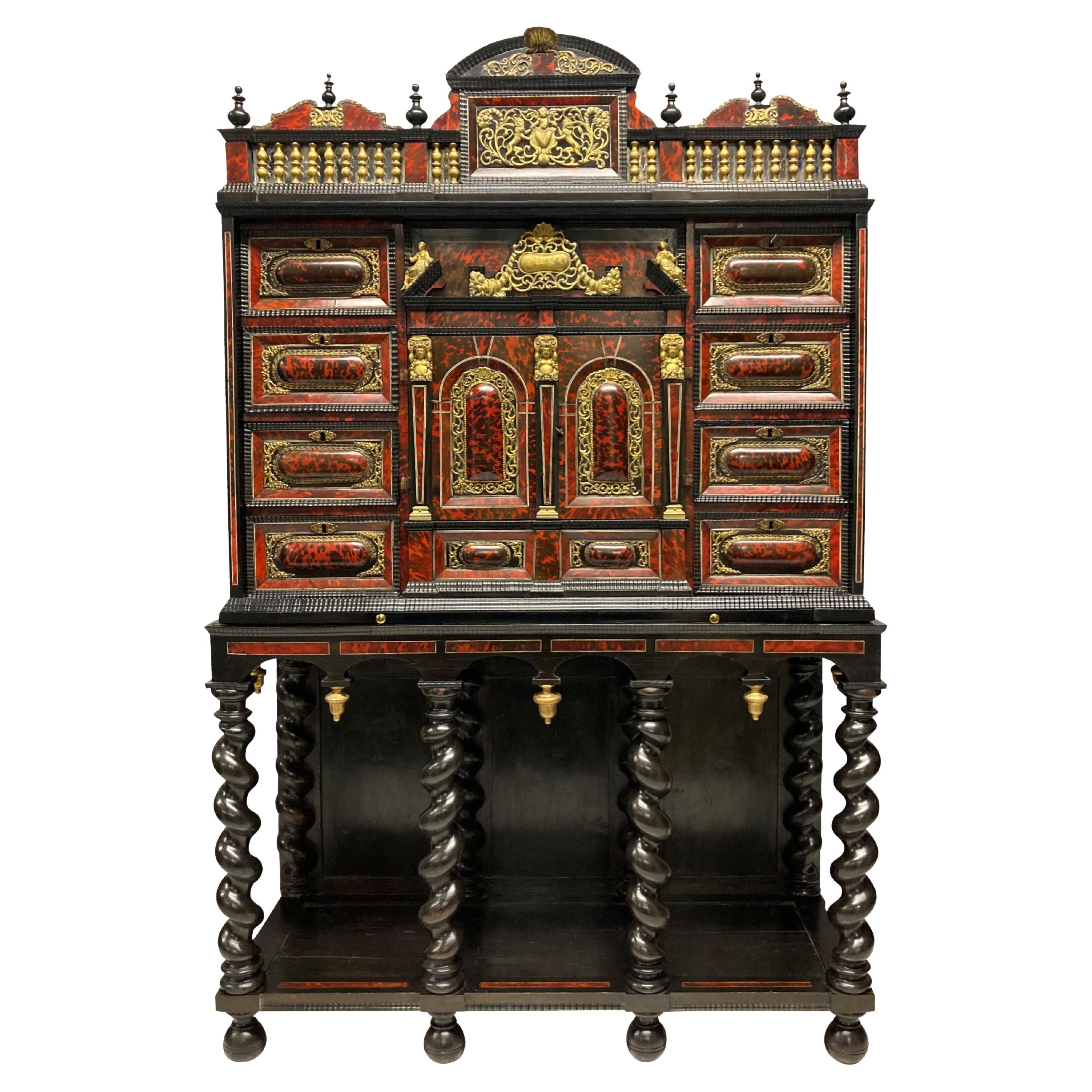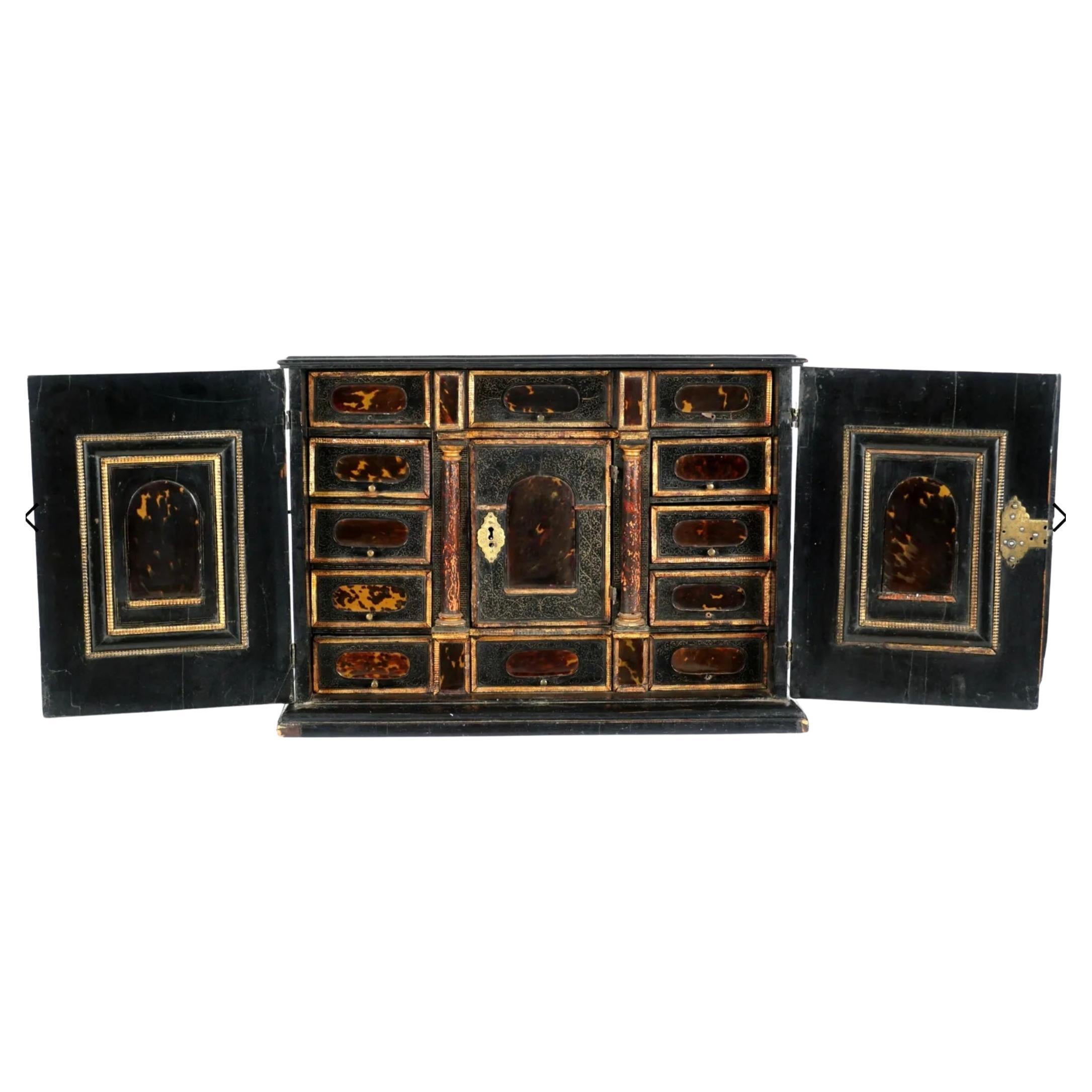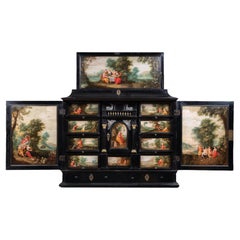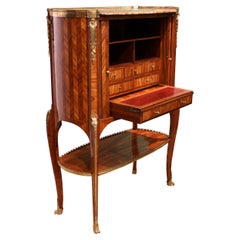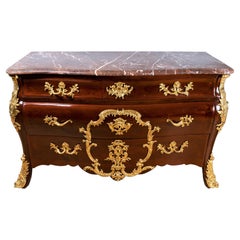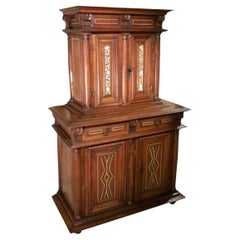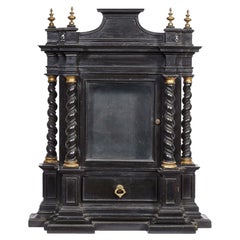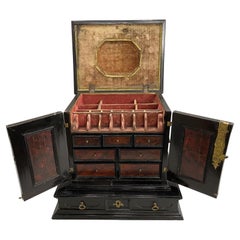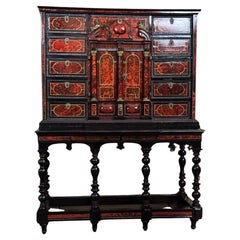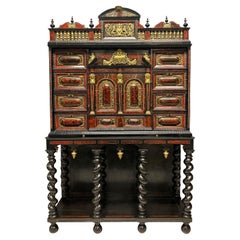Items Similar to A 17th century Augsburg ebonized cabinet with painted pietra paesina panels
Want more images or videos?
Request additional images or videos from the seller
1 of 15
A 17th century Augsburg ebonized cabinet with painted pietra paesina panels
$12,202.02
$15,252.5320% Off
£8,986.76
£11,233.4520% Off
€10,160
€12,70020% Off
CA$16,599.90
CA$20,749.8720% Off
A$18,446.15
A$23,057.6820% Off
CHF 9,665.98
CHF 12,082.4720% Off
MX$226,209.11
MX$282,761.3920% Off
NOK 123,283.90
NOK 154,104.8820% Off
SEK 115,980.97
SEK 144,976.2120% Off
DKK 77,346.52
DKK 96,683.1520% Off
Shipping
Retrieving quote...The 1stDibs Promise:
Authenticity Guarantee,
Money-Back Guarantee,
24-Hour Cancellation
About the Item
An ebonized wood cabinet with painted pietra paesina panels
Augsburg, southern Germany, mid-17th century
Dimensions: h. 43 cm, w. 32 cm, d. 20 cm
Ebonized wood, inlay of painted pietra Paesina plates
The cabinet we are presenting is a rare collector's item which is part of a series of objects intended for “kunstkammer” (curiosity cabinets).
Having no use in terms of storage, it was designed as a luxurious object of art with the sole function of reflecting the taste and extravagance of its owner and arousing the admiration and curiosity of his peers.
Like a facade of a miniature palace, it consists of a pediment resting on a drawer, doors revealing a series of drawers as well as a drawer in the lower part.
The clever middle drawer design hides a row of miniature secret drawers in the removable center compartment. This artifice testifies rather to the prowess and ingenuity of the cabinetmaker than to a real need to secure the objects contained therein.
The drawers are decorated with elliptical-shaped Paésine stone plaques inserted in blackened wooden frames. The doors welcome in their centers the Paésine plaques in the center of a carved cartouche with mascarons decorated with ribbons.
The Paésine plaques are enhanced with oil paintings mainly of small figures which blend into a natural background of the strata.
The theme adopted for the large plaques illustrates Christian virtues. The function of the subjects is to reflect and interpret the world in connection with the philosophical research of the owner of the “kunstkammer”.
The three virtues chosen by the sponsor are Faith and Hope for the large doors and Strength for the small door.
Faith is represented by a woman holding the cross, symbol of Christianity, and the book of the Gospels.
Hope is represented by a woman standing next to an anchor. The anchor symbolizes stability and assurance; this virtue allows the vacillating man to escape the turmoil of existence.
Strength is represented by a soldier carrying the broken column. The column, symbol of fortitude, is broken in allusion to the exploit of Samson, biblical hero, who embodies in his fight against the Philistines, an example of not only physical but also moral strength.
The drawers are decorated with figures in landscapes.
The contrast is striking between the sobriety of the blackened wood and the natural light colors of the Paésine stone. The painted miniature plaques inserted in the dark wood are particularly well highlighted like a painting with its frame. The natural formations of the pietra paesina imitating landscapes and trees provide a perfect background for painting some small figures.
Painting on stone
Painting on stone is a technique that appeared in Italy around 1530. The support promises exemplary durability over time, unlike traditional supports such as canvas or wood, which are considered fragile.
Secondly, from the years 1580-1590, artists varied their productions by using Supports such as jasper, amethyst, agate, or alabaster. The diversity and richness of the materials then meet two expectations: it corresponds to the taste for preciousness and is part of a complicity between art and nature. Florence and Rome became important centers of production and many families, including the Medici and the Barberini, played a key role in this development.
The Paesina stone: Pietra Paesina
Paesina is a variety of limestone found in northern Italy around Florence and in the Apennines, and which is particularly representative of image stones. This rock is also called ruiniform marble or limestone, landscape stone, figured stone or Florentine marble. Cut and polished, the successive plates present different designs on each edge. Greens, blues or grays suggest the sky and the sea; the brown veins of houses, castles, towers, dungeons, ruined villages or shores, cliffs and caves.
The use of this limestone as an ornamental stone dates back to Antiquity but it was in the 16th century that paésines were used for decorating furniture and cabinets. Indeed, the “pietra paesina” aroused the admiration of lovers of cabinets of natural curiosities during the Renaissance. The Medici decorated their Italian cabinets with it, making inclusions in hard stone marquetry. The paésines were sometimes painted, their fantastic decoration serving as a background for these stone paintings in the 17th and 18th centuries, very popular with collectors.
Augsburg collector's cabinets
There is a limited corpus of around ten cabinets whose drawers or doors are inlaid with painted hard stones, generally agate and jasper. They were made in Augsburg, and mostly were commissioned in the 1630s by Philip Heinhofer (1578–1647) (art dealer) for use by European princes.
His cabinets, like those in the collections of Uppsala University, the Rijksmuseum or the Florence Offices, were so exuberant and very expensive, leading to the ruin of Philippe Heinhofer, but must have inspired the cabinetmakers and artists of Augsburg to making models that are certainly less impressive but more accessible to collectors.
- Dimensions:Height: 16.93 in (43.01 cm)Width: 12.6 in (32.01 cm)Depth: 7.87 in (19.99 cm)
- Style:Renaissance (Of the Period)
- Materials and Techniques:
- Place of Origin:
- Period:Mid-17th Century
- Date of Manufacture:unknown
- Condition:Wear consistent with age and use.
- Seller Location:PARIS, FR
- Reference Number:1stDibs: LU8168239869122
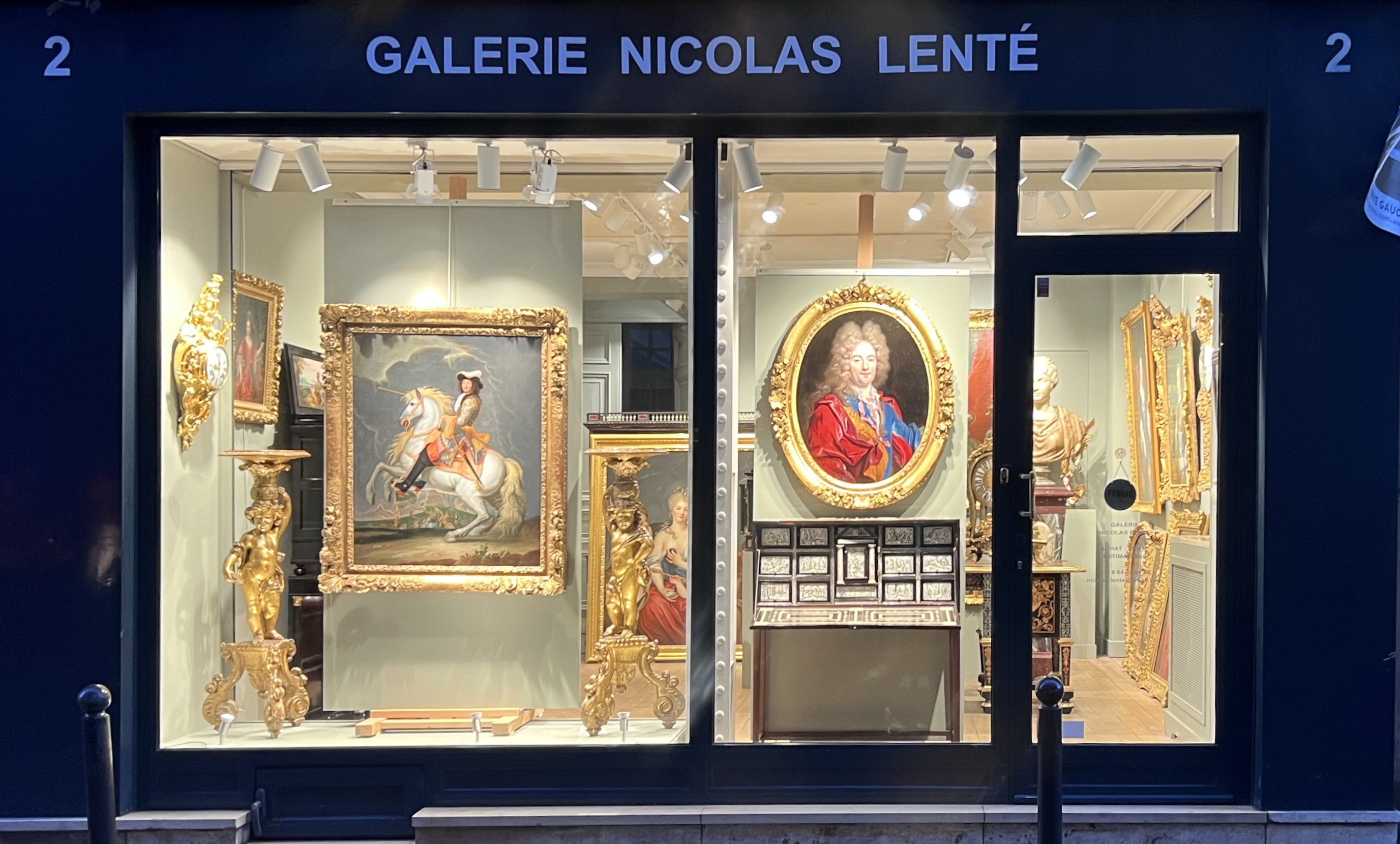
About the Seller
No Reviews Yet
Vetted Professional Seller
Every seller passes strict standards for authenticity and reliability
Established in 2011
1stDibs seller since 2023
- ShippingRetrieving quote...Shipping from: PARIS, France
- Return Policy
Authenticity Guarantee
In the unlikely event there’s an issue with an item’s authenticity, contact us within 1 year for a full refund. DetailsMoney-Back Guarantee
If your item is not as described, is damaged in transit, or does not arrive, contact us within 7 days for a full refund. Details24-Hour Cancellation
You have a 24-hour grace period in which to reconsider your purchase, with no questions asked.Vetted Professional Sellers
Our world-class sellers must adhere to strict standards for service and quality, maintaining the integrity of our listings.Price-Match Guarantee
If you find that a seller listed the same item for a lower price elsewhere, we’ll match it.Trusted Global Delivery
Our best-in-class carrier network provides specialized shipping options worldwide, including custom delivery.More From This Seller
View All17th century ebonized Antwerp cabinet with painted panels, circle 1630
Located in PARIS, FR
Cabinet
Antwerp, circa 1630, 17th century
Paintings on wood:
Circle of Hendrick van Balen (Antwerp, 1573–1632)
Dimensions: h. 86 cm, l. 102 cm, p. 47cm
This precious cabinet is one ...
Category
Antique 17th Century Belgian Baroque Cabinets
Materials
Wood
French 18th C. Louis XV/XVI Transitional Ormolu Mounted Secretaire by RVLC
By Roger Vandercruse dit Lacroix
Located in PARIS, FR
A Louis XV/XVI transitional ormolu mounted tulipwood secretaire by RVLC
Rare and elegant secretary of elliptical shape, veneered on all sides of rosewood with herringbone decoration...
Category
Antique 18th Century French Louis XV Secretaires
Materials
Bronze
$30,625 Sale Price
25% Off
French 18th Century Regence Ormolu-Mounted Commode by Etienne Doirat
By Etienne Doirat
Located in PARIS, FR
A Regence ormolu-mounted commode by Etienne Doirat (Paris, 1675-1732)
Rare and elegant commode curved on the front and on the sides, in amaranth veneer arranged in sheets in the frames. It opens with four drawers in three rows: two large and two short and asymmetrical .
Rich ornamentation of chiseled and gilt bronzes: the Rococo frontal cartouche, mounts with oak leaf windings, foliated handles and clogs, rosettes on the sides.
Flanders red marble top.
Size: h. 35.04 inch, w. 56.69 inch, d. 33.46 inch
By Etienne Doirat (1675-25 June 1732), Regency period, 18th century
Although not stamped, our commode belongs by its shape and its bronze ornamentations to an identified corpus of the production of Etienne Doirat, one of the most talented cabinetmakers under the Regency.
This group of chests of drawers listed in public and private collections, some of which stamped E. Doirat are characterized by the almost identical front cartouche.
On our chest of drawers, this cartouche is formed by two scalloped lambrequins joined by a clip they are extended by branches with acanthus foliage and flowers with beaded friezes. Inside are two keyholes, the first with a lion's mouth, the second formed by two stylized dolphins facing each other with lion's paws under a valance.
Chests of drawers by Etienne Doirat with the frontal cartouche:
Commode in identical "tombeau" shape:
- Commode stamped Doirat, Christie's London, July 10, 2008 lot n 43
- Unstamped chest of drawers, doc. Me Tajan, published in "French 18th century Furniture" by Kjelleberg
Commode of different shape, identical front cartouche:
- Chest of drawers with three drawers, stamped Doirat, Christie's London, November 27, 2018 lot n 509
- Sarcophagus chest of drawers, stamped Doirat, J. Paul Getty museum, Los Angeles
- Chest of drawers with two drawers, stamped Doirat, private collection, illustrated in J. - D. Augarde
- Chest of drawers with three drawers, stamped by Migeon, but attributed to Doirat from the former Eugène Kraemer collection, sale at Galerie Georges Petit (Paris), May 5-6, 1913, lot 141; former Ogden Mills collection, Paris, rue de Varenne...
Category
Antique Early 18th Century French Régence Commodes and Chests of Drawers
Materials
Marble, Bronze
$36,780 Sale Price
30% Off
A 16th Century Renaissance Cavred Walnut Buffet Loire Valley
Located in PARIS, FR
A 16th Century French Renaissance Cavred Walnut Buffet Loire Valley
Dimensions: H. 1m62; L. 1m02; P. 0.52m. (63.78 in. x 40.16 in x 20....
Category
Antique 16th Century French Cupboards
Materials
Walnut
A rare French Louis XIV large pewter and fruitwood inlaid marquetry desk
By Pierre Gole
Located in PARIS, FR
A rare French Louis XIV large pewter and fruitwood inlaid marquetry desk called “bureau Mazarin” attributed to Pierre Gole (1620 – 1684)
Dimensi...
Category
Antique Late 17th Century French Louis XIV Desks and Writing Tables
Materials
Bronze, Pewter
A large and exceptional 15th c. Gothic leather and iron bound travelling chest
Located in PARIS, FR
Large leather and iron bound travel chest, very rare in its dimensions
Late 15th century, Northern France
Dimensions: h.103 cm, w. 178 cm, d. 77cm ( (H. 40.55 in, w. 70.08 in. d. 30.31 in)
Our rectangular-shaped chest opens with a rounded lid. It is entirely covered in leather veneered on a wooden core, and decorated with wrought and crafted iron frames and hinges.
It is garnished on all sides with iron hinges cut at the ends of Gothic trefoils.
On the facade two lock plates with cut-out cloverleaf borders fitted with a hasp (one missing) attached to the cover.
The iron bands serving as reinforcements on all sides as well as the central bands are decorated with plant and floral friezes and geometric patterns. These strips are attached to the wood using daisy-headed nails, typical of the French Renaissance.
Given its size and loaded weight, our trunk has four carrying handles: two wrought iron side handles, but also two front handles.
The interior has a stretched fabric dating from at least the 17th century, we find on the interior sides of the cover the original raspberry-colored vellum.
This is a rare model in leather and iron of very large dimensions. Expensive materials, which were only used on small Gothic boxes (20 cm to 50 cm in length) like those in the public collections of many museums.
Large chests exceeding 1 meter in length for the sake of economy and simplicity were generally made of wood sometimes covered with iron cladding.
We found a large chest in the collections of the Metropolitan Museum of New York, but still smaller than ours (inv. 47.144, dim. H: 22 1/2" W: 50 1/2" D: 21").
There are also two similar large chests (with flat or slightly domed lids) in the collections of the Barcelona Leather...
Category
Antique 15th Century and Earlier French Gothic Blanket Chests
Materials
Wrought Iron
$33,627 Sale Price
20% Off
You May Also Like
An early 18th century Florentine Ebonized Wood Aedicule Case
Located in Leesburg, VA
An early 18th century Florentine ebonized wood aedicule case with gilt metal embellishments
Ambit of Leonard van der Vinne
Possibly first decade of the 18th century; Florence, Italy
Approximate size: 83.5 (h) x 69 (w) x 23 (d) cm
The cabinet’s centralized glass door is flanked by thick spiraling Solomonic columns surmounting a lower drawer. To the rear of the cabinet, the motif repeats in an eloquent display of perspectival treatment. The overall work is supported by a tiered base, elegantly conceived, and the cabinet is topped by a handsome pediment flanked by square plinths crested by gilt metal finials and an openwork frieze.
The cabinet’s tempered and moderate form suggests an origin probably during the first decade or quarter of the 18th century. Although utilitarian in concept, the reserved and sublime expressiveness of this cabinet is managed with a quality and care respective of the influence of Florentine ebony cabinetry work conceived in the Galleria dei lavori or Grand Ducal Workshops of the 18th century Medici dynasty. In particular, its base mouldings echo a remarkable Night Clock...
Category
Antique Early 18th Century Italian Baroque Vitrines
Materials
Brass
18th Century Flemish Collectors Cabinet with Ebonized Case & Brass Handles
Located in Milford, NH
A fine example of an 18th century Flemish ebonized collectors cabinet with hinged locking top and two front doors with faux red tortoise shell interior lining, opening to a velvet li...
Category
Antique 18th Century Belgian Cabinets
Materials
Brass
Important Antwerp Cabinet In Tortoiseshell, Ebony And Bronze, 17th Century
Located in Honnelles, WHT
Important Antwerp Cabinet In tortoiseshell, ebony And Bronze, theater in ebony and bone marquetry
Category
Antique 17th Century Belgian Louis XIII Cabinets
Materials
Bronze
Fine Flemish Baroque Late 17th Century Tortoiseshell Cabinet on Stand
Located in Kent, Dover
A rare and of fine quality, late XVII Century Flemish European ormolu mounted ebony and red tortoiseshell cabinet on stand, of architectural form, crowned with an architectural, gall...
Category
Antique 17th Century Dutch Baroque Cabinets
Materials
Tortoise Shell, Ebony, Pine
17th Century Italian Tortoiseshell Table Cabinet
Located in Bradenton, FL
17th century Ebonized case with parcel gilt decoration, iron handles and hinges. Fitted interior with inset tortoiseshell panels surrounded by brass filigree inlaid ebonized wood drawer and door fronts. Faux painted architectural columns on either side of center door which opens to reveal an additional set of small drawers. A rare early cabinet...
Category
Antique 17th Century Italian Renaissance Cabinets
Materials
Tortoise Shell
Italian Early 18th Century Baroque Period Inlaid Specimen Cabinet
Located in West Palm Beach, FL
An exceptional and most unique Italian early 18th century Baroque period ebonized fruit wood and Pietra Dura marble and semi precious stone inlaid specimen cabinet. The small scale cabinet...
Category
Antique 18th Century Italian Baroque Cabinets
Materials
Marble
More Ways To Browse
Curiosity Cabinets
17th Century Wood Panels
Cross Renaissance
17th Century Cross
17th Century Italian Plates
Antique Curiosity Cabinet
German Carved Cabinet
Ebonized Kitchen Cabinet
Standing Painted Cabinet
Antique Furniture With Secret Compartments
17th Century Italian Cabinet
Wood Corpus
Carved Cabinet With Figures
16th Century Cross
Medici Marble
Marquetry Wood Inlay Panel
Renaissance Plaque
Antique Cabinets With Secret Compartments
